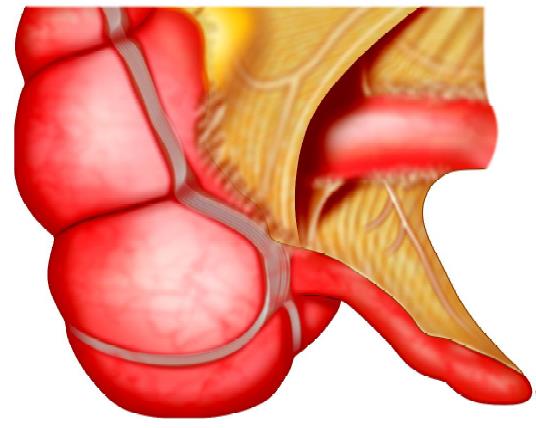Laparoscopic Appendicectomy
Appendicitis was first recognized as a disease entity in the sixteenth century and was called perityphlitis. McBurney described the clinical findings in 1889. Laparoscopic appendectomy in expert hands is now quite safe and effective. It is an excellent alternative for patients with acute appendicitis. The first successful laparoscopic appendicectomy was performed by Semm in 1982. Although laparoscopic appendicectomy can be performed in all groups of patients, surgeons agree that for women of childbearing age, laparoscopic appendectomy is unquestionably the method of choice.
Laparoscopic Anatomy
The appendix is derived from a cecal diverticulum of the fetus. The appendix is generally within 1.7 cm of the ileocecal junction. Its length varies from 2 to 20 cm, an average of 9 cm. Most of the time when the telescope is introduced through the umbilicus, the appendix is hidden behind the cecum.

Normal laparoscopic view of the appendix
The anterior tinea coli of the cecum is an important landmark that leads to the cecum. The triangular mesoappendix tethers the appendix posteriorly which contains appendicular artery and veins. The appendicular artery is a branch of the ileocolic artery. Laparoscopic exposure of the appendix is facilitated by gently pulling the cecum upward. The base of the appendix must be visualized to avoid leaving a remnant of the appendix at the time of laparoscopic appendicectomy. Exposures of retrocecal appendix require the mobilization of the right colon. The peritoneal reflection is incised, and the cecum is pulled medially to visualize retrocecal appendix.

Anatomic position of the appendix

Normal appendix
Advantage of Laparoscopic Appendectomy
Thorough exposure of the peritoneal cavity is possible.
Indications

Relative Contraindications
• Complicated appendicitis
• Stump appendicitis (develops after previous incomplete appendectomy)
• Poor risk for general anesthesia
• Some cases of previous extensive pelvic surgery.
The general anesthesia and the pneumoperitoneum required as part of the laparoscopic procedure do increase the risk in certain groups of patients. Most surgeons would not recommend laparoscopic appendectomy in those with pre-existing disease conditions. Patients with moderate cardiac diseases and chronic obstructive pulmonary disease (COPD) should not be considered a good candidate for laparoscopy. The laparoscopic appendectomy may also be more difficult in patients who have had previous lower abdominal surgery. The elderly may also be at increased risk for complications with general anesthesia combined with pneumoperitoneum.
Laparoscopic appendectomy has gained a lot of attention around the world. However, the role of laparoscopy for appendectomy, one of the commonest indications, remains controversial. Several controlled trials have been conducted, some are in favor of laparoscopy, others not. There is also diversity in the quality of the randomized controlled trials. The main variable in these trials are the following parameters:
• Number of patients in a trial
• Withdrawal of cases
• Exclusion of cases
• Blinding
• Intention to treat analysis
• Publication biases
• Local practice variation
• Prophylactic antibiotic used
• Follow-up failure.

Appendix hidden in the cannula is ejected out
Without proper attention to the detail of all the parameters, it is very difficult to draw a conclusion. It has been found among the surgeons that there is a hidden competition between laparoscopic surgeons and surgeons who are still doing conventional surgery, and this competition influences the result of the study. One should always think of laparoscopic surgery and open procedures as being complementary to each other.
A successful outcome requires greater skills from the operator. The result of many comparative studies has shown that outcome of a laparoscopic appendectomy was influenced by the experience and technique of the operator. Minimal access surgery requires different skills and technological knowledge. With a clear diagnosis of complicated appendicitis, the skill and experience of the surgeon should be considered for the selection of the operating methods. Surgeons should perform the procedure with which they are more comfortable.
Laparoscopic appendectomy is equally safe and can provide less postoperative morbidity in experienced hands, as in open appendectomy. Most cases of acute appendicitis can be treated laparoscopically. Laparoscopic appendectomy is a useful method for reducing hospital stay, complications, and return to normal activity. With better training in minimal access surgery now available, the time has arrived for it to take its place in the surgeon's repertoire.





